Doncaster: Difference between revisions
m clean up, typos fixed: Indutrial → Industrial, an 18th century → an 18th-century |
|||
| Line 56: | Line 56: | ||
|- | |- | ||
|| Ageloco | || Ageloco | ||
|| [[Littleborough]] | || [[Littleborough, Nottinghamshire|Littleborough]] | ||
|| XXI | || XXI | ||
|- | |- | ||
Revision as of 17:50, 11 January 2017
| Doncaster | |
| Yorkshire West Riding | |
|---|---|
 Doncaster skyline with St James Church | |
| Location | |
| Grid reference: | SE5702 |
| Location: | 53°30’58"N, 1°7’59"W |
| Data | |
| Population: | 67,977 (2001) |
| Post town: | Doncaster |
| Postcode: | DN1-DN12 |
| Dialling code: | 01302, 01405, 01427, 01709 |
| Local Government | |
| Council: | Doncaster |
| Parliamentary constituency: |
Doncaster – Central / North |
Doncaster is a major town in an urban belt of the West Riding of Yorkshire. It stands about 20 miles from the City of Sheffield, at the very edge of Yorkshire and its suburbs reaching out toward the Isle of Axholme in Lincolnshire.
Doncaster is popularly nicknamed "Donny", and for all its variety and its lively history as a centre of industry and innovation, it is perhaps best known for its racecourse.
Doncaster is an ancient town, but its modern history comes from the Industrial Revolution, in which it was a coal town and transport centre. The mines and mills have gone and Doncaster has suffered a decline familiar to the old mill towns, but is reinventing itself as many Yorkshire towns have had to do. It has an international airport (Robin Hood Airport Doncaster Sheffield) and in recent years its centre has undergone regeneration including the development of an Education City campus, currently the largest education investment of its kind in the United Kingdom.
Development
The Education City campus is a recent development and currently the largest education investment of its kind in the United Kingdom. Doncaster Lakeside, which is home to the Doncaster Rovers ground has undergone major development. With the opening of the Lakeside Village, a major retail outlet with some 45 retail shops and restaurants, the area is becoming more attractive to tourists.
According to the 2001 census, the urban sub-area of Doncaster had a population of 67,977. Together with Bentley and Armthorpe, it forms an urban area with a population of 127,851 in 2001.
History
Roman foundation

Doncaster is built on the site of a Roman fort which was constructed in the 1st century AD at a crossing of the River Don. Under Antoninus Pius the Notitia Dignitatum called this fort Danum, and it ppears to be the city named "Caer Daun" by Nennius. The name survived intp the Anglo-Saxon period and appears to have become in Old English Donne, hence the name "Doncaster: Donne fort.
Doncaster was home to the Roman Crispinian horse garrison, a cavalry unit which took its name from Crispus, son of Constantine the Great. Crispus, son of the Emperor, lived at Danum while his father was 40 miles further north at Eboracum (York).
The Notitia Dignitatum or 'Register of Dignitaries' was produced around the turn of the 5th century near the end of Roman rule in Britain and is an important document which contains the name of almost every military unit in the Roman Empire and the names of their respective garrison towns. The Doncaster entry is listed under the command of the Dux Britanniarum or the 'Duke of the Britons'. Doncaster provided an alternative direct land route between Lincoln and York, between which the main route was Ermine Street, though this meant crossing the Humber in boats which was not always practical.
The Roman road through Doncaster appears on two routes recorded in the Antonine Itinerary. The itinera include the same section of road between Lincoln and York, and list three stations along the route between these two coloniae. Iter VII and Iter VIII is entitled "the route from York to London", which allows us to identify the forts to their modern counterparts. The section below shows distances from Iter VIII.
| Roman town | Modern name | Miles |
|---|---|---|
| Eboraco | YORK | Start |
| Lagecio | Castleford | XXI |
| Dano | DONCASTER | XVI |
| Ageloco | Littleborough | XXI |
| Lindo | LINCOLN | XIII |
A route through the hills of the Peak District was opened in the latter half of the 1st century AD, possibly by the campaigning governor Gnaeus Julius Agricola during the late 70s, although the first section of the road to the Doncaster fort had probably been in existence since the early 50s.
Today, there are several areas of known intense archaeological interest however many, in particular St Sepulchre Gate, remain hidden under buildings. The Roman fort is believed to have been located on the site that is now St George's Minster next to the River Don.
Early and Mediæval history
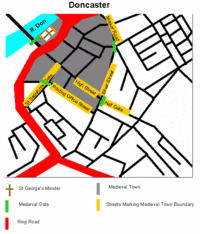
The town was an Anglo-Saxon burh, and is mentioned in the 1003 will of Wulfric Spott. Shortly after the Norman Conquest, Nigel Fossard refortified the town and constructed Conisbrough Castle. By the time of the Domesday Book, Hexthorpe was described as having a church and two mills; David Hey contends that these facilities represent the settlement at Doncaster. He also suggests that the street name Frenchgate indicates that Fossard invited fellow Normans to trade in the town.[1]
In the early 12th Century as a result of the Treaty of Durham (1136) Doncaster became a possession of the Kingdom of Scotland as part of the peace treaty; the transfer of authority is thought to have never been formally reversed.[2]
As the 12th century approached, Doncaster matured into a busy town and in 1194 King Richard I granted Doncaster national recognition with a town charter. Doncaster suffered and recovered from a disastrous fire in 1204. At this time, buildings were built of wood and fire was a constant hazard.
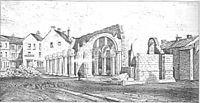
In 1248 a charter was granted for Doncaster Market to be held around the Church of St Mary Magdalene, which in the 16th century became the town hall and was ultimately demolished in 1846.[1] Some 750 years on, the market still exists with its busy stalls located both outside and under cover. The market also occupies the 19th century 'Corn Exchange' building, opened in 1873[3] and extensively rebuilt in 1994 after a major fire.
During the 14th century a number of friars arrived in Doncaster who were known for their religious enthusiasm and preachings. In 1307 Franciscan friars (Greyfriars) arrived, and Carmelites (Whitefriars) arrived in the middle of the 14th century. In the Mediæval period, other major features of the town included the Hospital of St Nicholas and leper colony of the Hospital of St James, a moot hall, grammar school, and the five-arched stone town bridge with a chapel dedicated to Our Lady of the Bridge. By 1334 Doncaster was the wealthiest town in southern Yorkshire and the sixth most important town in Yorkshire as a whole, even boasting its own banker. By 1379 it was recovering from the Black Death and had a population of around 1,500 people. By 1547 its population exceeded 2,000. The town was incorporated in 1461, and its first Mayor and corporation were established.[1]
Many of Doncaster's streets are named with the suffix 'gate'. The word 'gate' is derived from the old Danish word 'gata' which meant street. During Mediæval times, craftsmen or tradesmen with similar skills, tended to live in the same street. Baxter is an ancient word for baker thereby confirming that Baxtergate was the bakers' street. It is assumed that 'Frenchgate' may be named after French-speaking Normans who settled on this street.
The Mediæval township of Doncaster is known to have been protected by earthen ramparts and ditches leaving four substantial gates as entrances to the town. These gates were located at Hall Gate, St. Mary's Bridge (old), St. Sepulchre Gate and Sunny Bar. Today the gates at Sunny Bar are commemorated by huge 'Boar Gates', similarly, the entrance to St. Sepulchre Gate is commemorated with white marble 'Roman Gates'. The boundary of the town principally extended from the River Don, along what is now Market Road, Silver Street, Cleveland Street and Printing Office Street.
Early Modertn Period
Because access into town was limited by the four gates in the walls, some officeholders secured charters to collect tolls. In 1605, King James I granted to William Levett of Doncaster, brother of York merchant Percival Levett, the right to levy tolls at Friar's and St Mary's Bridges, and since the family had served as mayors and aldermen of Doncaster, the Levetts were in a position to enforce their new privilege, and in 1618 the Levetts began enforcing the tolls. By 1628 however the populace revolted. Captain Christopher Levett, Percival's son, petitioned Parliament for his right but Parliament disagreed, calling the tolls "a grievance to the subjects, both in creation and execution," and removed the Levett monopoly.[4] (Doncaster's Levet Road is named for this family, as are the nearby hamlets of Hooton Levitt and the largely extinct Levitt Hagg, where much of the town's early limestone was quarried.)
During the 16th and 17th centuries the town of Doncaster continued to expand. This was despite several outbreaks of plague between 1562 and 1606. Each time the plague struck down significant numbers of Doncaster's population.
During the campaign of the First English Civil War, King Charles I marched by Bridgnorth, Lichfield and Ashbourne to Doncaster, where on 18 August 1645 he was met by great numbers of Yorkshire gentlemen who had rallied to his cause. On 2 May 1664, Doncaster was rewarded with the title of 'Free Borough' by way of the King expressing his gratitude for Doncaster's allegiance.
Later history
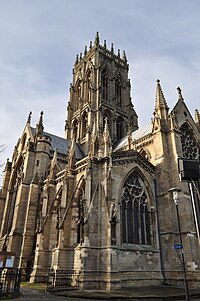
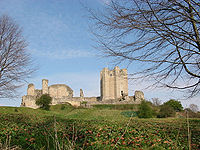
Doncaster has traditionally been a prosperous area. The borough was known for its rich landowners with vast estates and huge stately homes such as Brodsworth Hall, Cantley Manor, Cusworth Hall, Hickleton Hall, Nether Hall and Wheatley Hall. This wealth is evidenced in the luxurious and historic gilded 18th century Mansion House on High Street. This land ownership developed what is an ancient market place and large 19th century Market Hall and Corn Exchange buildings. Perhaps the most striking building is St George's Minster (the parish church, promoted to minster status in 2004).
Doncaster was already a communications centre at this time. Doncaster sat on the Great North Road and had held a strategic geographical importance since Roman times; the road was the primary route for all traffic from London to Edinburgh and Doncaster benefitted from its location.
Doncaster emerged as an industrial centre in the late 18th century to 20th century. Its communication links, particularly its waterways, meant that Doncaster became extremely busy and experienced vast migration to its centre. Underneath Doncaster lies a huge natural resource by way of deep seam coal. Recently there has been an expansion in commercial and residential developments along with good transportation links with the rest of the United Kingdom. Coal prompted exponential population growth. The waterways, the River Don and Don Navigation were used to transport coal from Doncaster to the steel centres at Rotherham, Scunthorpe and Sheffield.
In the early part of the 20th century Doncaster became one of the largest coal mining areas in the country, with the industry employing more people in the area than anything else. With coal mining came secondary and tertiary industries. Large-scale glass works soon followed using coal-fired furnaces. Several specialist glass manufacturers remain to this day, such as Rockware Glass. A factory for chemical polymers was built on Wheatley Hall Road and was the largest facility of its type in Europe. It changed hands numerous times during its existence until DuPont closed it in the mid-1990s.
Steel foundries, rolling mills and wire mills were built close to the railways that brought steel from Rotherham and Sheffield. Bridon Ropes produces wire rope, including the ropes used at coal mines to haul coal and miners. It is claimed to be the largest wire rope manufacturing plant in Europe. Bridon has recently supplied wire rope for the Olympic Stadium for the 2012 Olympic Games.
During First World War and Second World War, the town became involved in munitions manufacture.
Closure of coal mines in the 1970s and the early 1980s caused some economic difficulties. Today, coal mining has been all but eliminated from the area, with only a handful of collieries surviving. The demise of coal saw a cascade effect which saw the removal of many other tertiary industries. However, several companies diversified and can still be seen today as the town has developed its service industry; the good communication links with the rest of Britain support this development.
Shape of the town
The Doncaster skyline is dominated by St George's Minster in the middle of the town. The Frenchgate Shopping Centre holds an important position in the skyline, along with the Doncaster College Hub building and Cusworth Hall.
Cusworth Hall is an 18th-century Grade I listed country house in Cusworth, near Doncaster. Set in the landscaped parklands of Cusworth Park, Cusworth Hall is a good example of a Georgian country house.
The old Doncaster College, the Council House and surrounding buildings have been demolished, and work has commenced to replace them with more modern facilities including a new theatre, council house and hotel which together will form the Doncaster Civic and Cultural Quarter. There are also plans for expansion onto land north of the new college (The Hub).
Potteric Carr, including Potteric Carr Nature Reserve, lies to the south.
Industry
Distribution centres
Due to its proximity to major urban centres and motorway/rail infrastructure, Doncaster has a number of major distribution centres, including the Doncaster International Railport, which dispatches goods to Europe by rail. Large warehousing and logistic capabilities for major retailers. A significant proportion of fresh and frozen goods for northern supermarkets is dispatched by road from Doncaster.
Confectionery
During the 19th and 20th century a number of confectioners were based in Doncaster including Parkinson's Doncaster Butterscotch Company[5] the inventors of butterscotch, Nuttalls Mintoes[6] and Murray Mints.
The railways and locomotive works
During Industrial Revolution the railway came to Doncaster, and the Great Northern Railway established the Doncaster Locomotive and Carriage Building Works. The reasons for this were Doncaster's communication links, the necessity to transport coal quickly and efficiently and Doncaster's expertise in specialist metal products. An extensive housing programme was undertaken for the increased population. The Chairman of the Great Northern, anxious about the workers and their families' spiritual welfare, persuaded the directors to contribute towards the building of St James' Church, which became known as the "Plant Church". The railway also built St James' School. The Doncaster Plant became famous for building London and North Eastern Railway's famous 4-6-2 locomotives the Mallard and the Flying Scotsman, and many thousands more.[7]
Today, Doncaster railway station, on the East Coast Line, is linked to many towns and cities including Wakefield, Leeds, Kingston upon Hull, Sheffield, Manchester, Birmingham, London, York, Darlington, Newcastle upon Tyne, Berwick upon Tweed, Edinburgh, Motherwell, Glasgow, and Lincoln.
Doncaster PSB is one of the largest signalling centres on the UK network, controlling hundreds of route miles of railway. Doncaster International Railport is an important road-rail intermodal terminal.
Aviation
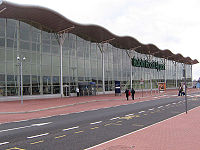
In 1909 Doncaster Racecourse was chosen as the venue for an airshow, after the world's first air display in Reims, France in 1908. All the world's leading aviators were present. An American pilot named Samuel F Cody attempted to win a prize offered by the Daily Mail for the first British pilot in a British aeroplane to fly a circular mile; he signed British naturalisation papers in front of the crowd with the band playing both God Save the King and the Star Spangled Banner. Unfortunately, he crashed his British Army Aeroplane No.1 whilst taxiing.
During First World War fighters based first from the racecourse, then a temporary airstrip near Finningley (later RAF Finningley and now Robin Hood Airport Doncaster Sheffield) and finally, in 1916, from a newly-built airfield alongside the racecourse, were deployed to defend the east coast against Zeppelins. On a number of occasions fighters took off to search for the intruders but none were ever seen. The Royal Flying Corps station trained pilots for the war in France. Within months of the war ending the entire station was put up for sale and two of its three Belfast hangars, the same type of hangar that now forms the basis for the Royal Air Force Museum at Hendon, were sold to a Sheffield motor manufacturing company for storage and assembly at Finningley. The third of the hangars stayed in place, mainly housing buses, until the 1970s when it was knocked down and replaced with modern buildings.
In 1920 the Government asked local authorities to assist in the formation of a chain of airfields so the country would not lag behind other nations in the provision of civil air services. Doncaster took heed and, with expert advice from Alan Cobham, on 26 May 1934, opened its 'aviation centre'. Development of the airfield continued and on 1 July 1936 an international service was opened to Amsterdam. On 1 November 1938, after long discussions with the Air Ministry, 616 (South Yorkshire) Squadron of the Royal Auxiliary Air Force was formed. Shortly after the outbreak of war in 1939 the squadron went to its battle station and played a part in the Battle of Britain. After the departure of 616 squadron its place was taken by the formation of 271 (Transport) Squadron composed mainly of requisitioned civilian aircraft and obsolescent twin engined bombers. 616 squadron was the first Allied jet fighter squadron, equipped with the Gloster Meteor, famed for using their wingtips to throw German V-1 Flying Bombs off course. In 1944, after being equipped with American-made Douglas DC-3 "Dakotas", the squadron moved south to take part in Operation 'Overlord' and later in the airborne invasion at Arnhem where Flight Lieutenant David Lord was awarded a posthumous Victoria Cross.
After the war the airfield reverted to civilian flying and finally closed in 1992.
Tractors

In 1930, International Harvester (IH) started the manufacture of agricultural implements at a factory on Wheatley Hall Road and later at another in the Carr Hill area of Doncaster. The first tractor built at the factory was a Farmall M, which came off the line on 13 September 1949.[8] Tractors were initially built from parts shipped from the United States. The Wheatley Hall Road factory was extended after the war with a new foundry to make the heavy castings. The factory started Crawler tractor production in 1953. By 1960 the factory was making a range of tractors from scratch, designed specifically for British and European markets, and sold under the 'McCormick International' name. Assembly moved in 1965 to the Carr Hill plant. In 1983 tractor production was moved to IH's other Doncaster factory at Wheatley Hall. In 1985, International Harvester sold its agricultural division to Tenneco, Inc. which then merged the operation with its subsidiary J.I. Case to form Case IH, who continued to design and build its European tractor range in Doncaster, shutting the David Brown Ltd tractor factory near Huddersfield. The 350,000th tractor came off the production line in 1999.
In 2000, the factory was purchased by ARGO SpA, an Italian-based agricultural equipment builder. Doncaster was the sole production site of the McCormick Tractors brand, and the factory employed around 380 people (although approximately 1,100 people are employed in the worldwide McCormick group). In December 2006 the parent company, ARGO Spa, announced that the Doncaster facility was to close in 2007 with the loss of around 325 jobs. The announcement was made only one week before Christmas. 61 years of tractor production in Doncaster came to an end in 2007 when McCormick tractor production was moved to Italy.
Culture and tourism
Doncaster Museum, the town's main museum opened in 1964, and explores natural history, archaeology, local history, and fine and decorative art.[9] It has a major exhibit dedicated to silverware and trophies won at Doncaster Racecourse. The museum houses the Regimental Museum of the King's Own Yorkshire Light Infantry.
The aircraft museum Aeroventure is based on the site of the former site of RAF Doncaster at Doncaster Lakeside. TheTrolleybus Museum in the nearby village of Sandtoft, Lincolnshire specialises in the preservation of trolleybuses, and claims to have the largest collection of preserved trolleybuses in Europe, with over 60 examples. Markham Grange Steam Museum, in a garden centre in the nearby village of Brodsworth, features a private collection of steam engines.
Cusworth Hall is an 18th-century Grade I listed country house in Cusworth. It is open to the public and features displays documenting the history of the West Riding. Doncaster Mansion House features an art gallery and displays on local history.
The 495 seat Doncaster Civic Theatre shows a mix of professional and local amateur productions.[10] The 100-seat Doncaster Little Theatre is a community theatre which also shows films.[11] The town has a 7 screen multiplex Vue Cinemas|Vue. Events and concerts take place at Doncaster Racecourse and The Dome Leisure Centre.
Sports and leisure
Doncaster Racecourse
From around the 16th century, Doncaster embraced the wealthy stagecoach trade. This led to horse breeding in Doncaster, which in turn led to the start of horseraces there. The earliest important race in Doncaster's history was the Doncaster Gold Cup, first run over Cantley Common in 1766. The Doncaster Cup is the oldest continuing regulated horserace in the world.
Ten years later the racecourse moved to its present location and in 1776 Colonel Anthony St. Leger founded a race in which five horses ran. This race has remained in existence and become the world's oldest classic horserace. During the First World War the racecourse was used for military purposes and substitute races were run instead at Newmarket from 1915 to 1918.
Doncaster has the distinction of both starting and ending the flat season on turf. Every September, Doncaster hosts the four-day Ladbrokes St. Leger Festival. Doncaster has also taken over events whose traditional homes have closed, such as the Lincoln Cup in 1965.
More history was made at Doncaster in 1992 when it staged the first ever Sunday meeting on a British racecourse. A crowd of 23,000 turned up despite there being no betting.
Today the St Leger Stakes remains the world's oldest classic horserace and features in the horseracing calendar as the 5th and final Classic of the British flat racing season. This takes place every September on the Town Moor course.
Doncaster is a left-handed, pear-shaped track of around 1-mile 7½ furlongs which is mostly flat. There are courses for Flat racing and also for National Hunt racing.
Others
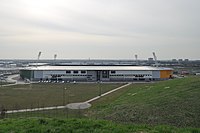
- Football:
- Doncaster Rovers FC
- Doncaster Rovers Belles LFC (women's football)
- Rugby Union: Doncaster Knights
- Rugby League: Doncaster RLFC (formerly the Doncaster Dragons RLFC and Doncaster Lakers)
Outside links
| ("Wikimedia Commons" has material about Doncaster) |
References
- ↑ 1.0 1.1 1.2 Hey, David. Mediæval South Yorkshire. Ashbourne: Landmark Pub.. ISBN 1-84306-080-9. OCLC 54874386.
- ↑ Tom Peterson (19 Feb 2012). "Scottish independence: English town of Doncaster stakes its claim to Scottish heritage". www.scotsman.com. http://www.scotsman.com/scotland-on-sunday/politics/scottish_independence_english_town_of_doncaster_stakes_its_claim_to_scottish_heritage_1_2125780.
- ↑ http://public-art.shu.ac.uk/pmsa/doncaster/00000046.htm Corn Exchange Public Art (with details of construction date)
- ↑ Collections of the Maine Historical Society, James Phinney Baxter, Maine HIstorical Society, Portland, 1893]
- ↑ "Official Website of Parkinson's confectionery – The confectioners. Traditional Doncaster Butterscotch, Toffee, Fudge". www.doncasterbutterscotch.com. http://www.doncasterbutterscotch.com/. Retrieved 23 April 2009.
- ↑ "Doncaster Museum". www.townfield.doncaster.sch.uk. http://www.townfield.doncaster.sch.uk/pages/danum/doncaster_museum.htm. Retrieved 23 April 2009.
- ↑ Larkin. The Railway Workshops of Britain, 1823–1986. London: Macmillan. ISBN 0-333-39431-3. OCLC 59095511.. By August 2008, the whole Plant complex had been razed to make way for a very large housing development.
- ↑ The Roar of Dust and Diesel A story of International Harvester Doncaster, by Mike Teanby, published by Japonica Press (2004), ISBN 1-904686-06-0
- ↑ "places to visit in Doncaster". visitdoncaster.co.uk. http://www.visitdoncaster.co.uk/Tourism/places_to_visit/Museum.asp.
- ↑ url=http://www.doncastercivic.co.uk/about%7Ctitle=Doncaster Civic Theatre
- ↑ url=http://www.doncasterlittletheatre.co.uk/index.php?option=com_content&view=article&id=17&Itemid=43%7Ctitle=Doncaster Little Theatre
